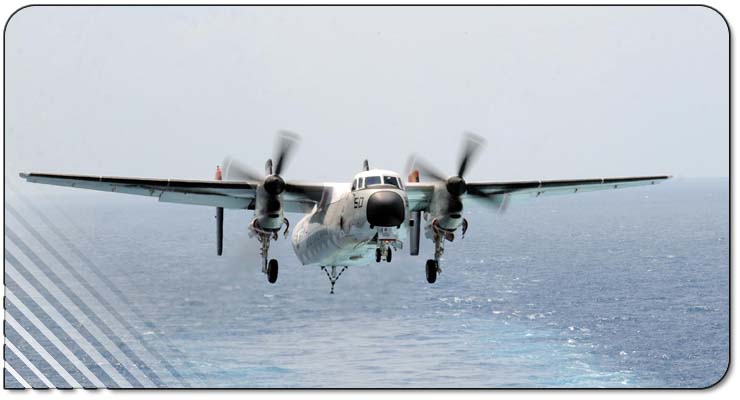Description:
A high wing, twin-engine
monoplane cargo aircraft, designed to land on aircraft carriers.
Features
The C-2A Greyhound
provides critical logistics support to Carrier Strike Groups. Its
primary mission is the transport of high-priority cargo, mail and
passengers between carriers and shore bases. Powered by twin Allison
T56-A-425 turboprop engines and Hamilton-Standard constant speed
propellers, the C-2A can deliver a combined payload of 10,000 pounds
over a distance in excess of 1,000 nm. The interior arrangement of the
cabin can readily accommodate cargo, passengers and litter patients.
Priority cargo such as jet engines can be transported from shore to
ship in a matter of hours. A cargo cage system or transport stand
provides restraint for loads during launches and landings.
The
large aft cargo ramp/door and a powered winch allow straight-in rear
cargo loading and unloading for fast turnaround. The C-2A's in-flight
ramp open capability allows airdrop of supplies and personnel. Its
on-board Auxiliary Power Unit provides engine-starting capability and
ground power self-sufficiency in remote areas provides an operational
versatility found in no other cargo aircraft.
Background
The C-2A Greyhound is a derivative of the E-2
Hawkeye and replaced the
piston-engine powered C-1 Trader in the Carrier
On-board Delivery role. The C-2A shares wings, and empennage with the
E-2 Hawkeye,
but has a widened fuselage with a rear loading ramp. The first of two
prototypes flew in 1964 and production began the following year. The
original C-2A aircraft were overhauled to extend their operational life
in 1973. In 1984, a contract was awarded for 39 new C-2A aircraft to
replace the earlier airframes. Dubbed the Reprocured C-2A due to the
similarity to the original aircraft, the new C-2A includes substantial
airframe and avionic systems improvements. All the older C-2As were
phased out in 1987, and the last of the new models was delivered in
1990.
During the period November 1985 to February 1987, VR-24,
operating with seven Reprocured C-2As, demonstrated exceptional
operational readiness while delivering two million pounds of cargo, two
million pounds of mail and 14,000 passengers in support of the European
and Mediterranean Theatre commands. The C-2A also provided support to
the Carrier Strike Groups during Operations Desert Shield and Desert
Storm, and is presently supporting Operation Enduring Freedom.
The
aircraft is currently undergoing a Service Life Extension Program
(SLEP) to increase its operating service life from 15, 020 landings and
10, 000 flight hours to 36, 000 landings and 15, 000 flight hours. The
changes being incorporated are; Structural Enhancements, aircraft
Rewire, Avionics Systems improvements and a new propeller system.
Additionally, as mandated by Congress and the Chief of Naval
Operations, two passenger carrying safety requirements are being
integrated into the C-2A. They are Traffic Alert and Collision
Avoidance System and Terrain Awareness Warning System. The SLEP is
necessary to make the C-2A a viable and economically maintainable
platform until it is replaced. |
WEFT Description
-
- WINGS
- ENGINE
- FUSELAGE
- TAIL
|
|

